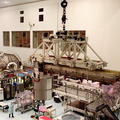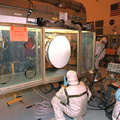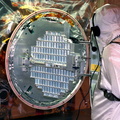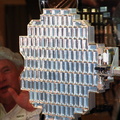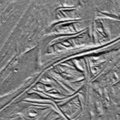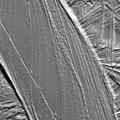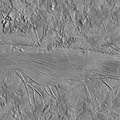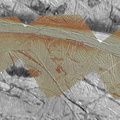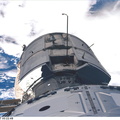![Agenor Linea is an unusual feature on Jupiter's icy moon Europa since it is brighter than its surroundings while most of Europa's ridges and bands are relatively dark. During the Galileo spacecraft's 17th orbit of Jupiter, high resolution images were obtained of Agenor Linea near Europa's day/night boundary so as to emphasize fine surface details. This mosaic shows high resolution images embedded in slightly lower resolution images which were also acquired during the 17th orbit. The Galileo images show that Agenoris not a ridge, but is relatively flat. Its interior consists of several long bands, just one of which is the very bright feature known as Agenor. Each long band shows fine striations along its length. A few very small craters pockmark Agenor Linea and its surroundings. Agenor is cut by some narrow fractures, and by some small subcircular features called lenticulae. Rough chaotic terrain is visible at the top and bottom of this photo, and appears to be eating away at the edges of Agenor. Though previously it was suspected that Agenor Linea might be one of the youngest features on Europa, this new [sic] view shows that it is probably not.
North is to the upper right of the picture and the sun illuminates the surface from the east. The image, centered at 44 degrees south latitude and 219 degrees west longitude, covers an area approximately 130 by 95 kilometers (80 by 60 miles). The highest resolution images were obtained at a resolution of about 50 meters (165 feet) per picture element and are shown here in context at about 220 meters per picture element. The images were taken on September 26th, 1998 at ranges as close as 5000 kilometers (3100 miles) by the Solid State Imaging (SSI) system on NASA's Galileo spacecraft.
The Jet Propulsion Laboratory, Pasadena, CA manages the Galileo mission for NASA's Office of Space Science, Washington, DC. PIA01646.jpg](i.php?/upload/2024/01/15/20240115163742-61397d55-me.jpg)
WIKIARCHIVES.SPACE
The Human Spaceflight Archive
![Agenor Linea is an unusual feature on Jupiter's icy moon Europa since it is brighter than its surroundings while most of Europa's ridges and bands are relatively dark. During the Galileo spacecraft's 17th orbit of Jupiter, high resolution images were obtained of Agenor Linea near Europa's day/night boundary so as to emphasize fine surface details. This mosaic shows high resolution images embedded in slightly lower resolution images which were also acquired during the 17th orbit. The Galileo images show that Agenoris not a ridge, but is relatively flat. Its interior consists of several long bands, just one of which is the very bright feature known as Agenor. Each long band shows fine striations along its length. A few very small craters pockmark Agenor Linea and its surroundings. Agenor is cut by some narrow fractures, and by some small subcircular features called lenticulae. Rough chaotic terrain is visible at the top and bottom of this photo, and appears to be eating away at the edges of Agenor. Though previously it was suspected that Agenor Linea might be one of the youngest features on Europa, this new [sic] view shows that it is probably not.
North is to the upper right of the picture and the sun illuminates the surface from the east. The image, centered at 44 degrees south latitude and 219 degrees west longitude, covers an area approximately 130 by 95 kilometers (80 by 60 miles). The highest resolution images were obtained at a resolution of about 50 meters (165 feet) per picture element and are shown here in context at about 220 meters per picture element. The images were taken on September 26th, 1998 at ranges as close as 5000 kilometers (3100 miles) by the Solid State Imaging (SSI) system on NASA's Galileo spacecraft.
The Jet Propulsion Laboratory, Pasadena, CA manages the Galileo mission for NASA's Office of Space Science, Washington, DC. PIA01646.jpg](i.php?/upload/2024/01/15/20240115163742-61397d55-me.jpg)
Agenor Linea is an unusual feature on Jupiter's icy moon Europa since it is brighter than its surroundings while most of Europa's ridges and bands are relatively dark. During the Galileo spacecraft's 17th orbit of Jupiter, high resolution images were obtained of Agenor Linea near Europa's day/night boundary so as to emphasize fine surface details. This mosaic shows high resolution images embedded in slightly lower resolution images which were also acquired during the 17th orbit. The Galileo images show that Agenoris not a ridge, but is relatively flat. Its interior consists of several long bands, just one of which is the very bright feature known as Agenor. Each long band shows fine striations along its length. A few very small craters pockmark Agenor Linea and its surroundings. Agenor is cut by some narrow fractures, and by some small subcircular features called lenticulae. Rough chaotic terrain is visible at the top and bottom of this photo, and appears to be "eating away" at the edges of Agenor. Though previously it was suspected that Agenor Linea might be one of the youngest features on Europa, this new [sic] view shows that it is probably not.
Information
- Taken in
- Author
- NASA/JPL-Caltech
- Description
-
Agenor Linea is an unusual feature on Jupiter's icy moon Europa since it is brighter than its surroundings while most of Europa's ridges and bands are relatively dark. During the Galileo spacecraft's 17th orbit of Jupiter, high resolution images were obtained of Agenor Linea near Europa's day/night boundary so as to emphasize fine surface details. This mosaic shows high resolution images embedded in slightly lower resolution images which were also acquired during the 17th orbit. The Galileo images show that Agenoris not a ridge, but is relatively flat. Its interior consists of several long bands, just one of which is the very bright feature known as Agenor. Each long band shows fine striations along its length. A few very small craters pockmark Agenor Linea and its surroundings. Agenor is cut by some narrow fractures, and by some small subcircular features called lenticulae. Rough chaotic terrain is visible at the top and bottom of this photo, and appears to be "eating away" at the edges of Agenor. Though previously it was suspected that Agenor Linea might be one of the youngest features on Europa, this new [sic] view shows that it is probably not.
North is to the upper right of the picture and the sun illuminates the surface from the east. The image, centered at 44 degrees south latitude and 219 degrees west longitude, covers an area approximately 130 by 95 kilometers (80 by 60 miles). The highest resolution images were obtained at a resolution of about 50 meters (165 feet) per picture element and are shown here in context at about 220 meters per picture element. The images were taken on September 26th, 1998 at ranges as close as 5000 kilometers (3100 miles) by the Solid State Imaging (SSI) system on NASA's Galileo spacecraft.
The Jet Propulsion Laboratory, Pasadena, CA manages the Galileo mission for NASA's Office of Space Science, Washington, DC.
- Created on
- Monday 7 December 1998
- Albums
- US SPACE PROGRAM / PROBES / JUPITER / GALILEO / Mission Photos (Edited) / JUPITER / EUROPA
- Source link
- https://photojournal.jpl.nasa.gov
- Visits
- 15
- Rating score
- no rate
- Rate this photo
- License
- Public Domain
- Modified by WikiArchives
- No (original)
- Downloads
- 0
Powered by Piwigo



